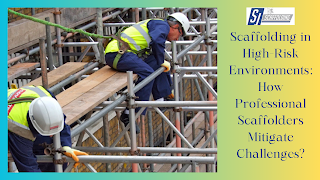Scaffolding in High-Risk Environments: How Professional Scaffolders Mitigate Challenges?
Working at extreme heights on construction sites comes with immense risks and challenges. Scaffolding provides a safer working platform for workers in these high-risk environments.
This blog will examine the unique risks faced by professional scaffolders working high above the ground. It will also discuss how they work to prevent such incidents.
Risks and Challenges in High-Risk Environments
Constructing scaffolds hundreds of feet in the air poses severe risks and difficulties for expert scaffolders. Working at extreme heights means even a small mistake could lead to a deadly fall.
Strong winds at height make scaffolds unstable and increase the chances of collapse or falling equipment/tools. The limited workspace requires careful manoeuvring and coordination when installing scaffolding components. Moreover, the remote location makes quick evacuation or medical assistance impossible if an accident occurs.
Mitigating Challenges in High-Risk Environments through Scaffolding
Professional scaffolders utilise various techniques and best practices to construct safe scaffolds and mitigate risks even in extreme conditions.
Strict compliance with local regulations and scaffold standards is the first step. In the UK, scaffolders follow standards set by organisations like NASC and CISRS for:
- Scaffold erection
- Inspection
- Use of fall protection
- Training requirements and more.
Rigorous inspection regimes are implemented, like handover certificates to ensure scaffold integrity when changing work crews.
Using the right scaffold components and materials also enhances safety. Scaffold tubes, couplers, boards and more are designed to bear heavy loads. Elements like base plates distribute weight to prevent the scaffold from sinking or tipping over. Professional scaffolders select components carefully to build stable and robust scaffolds.
Erecting scaffolds properly is vital. Scaffolds must have adequate ties to the building, with more ties added as height increases to resist wind loads.
Expert scaffolders ensure structural integrity by installing ample standards, ledgers, transoms and diagonals. This creates redundancies, thus, the load is distributed evenly. Proper access like ladders is also provided.
Wind loading is a major concern. Thus, scaffolders use techniques like sheeting and debris netting to reduce wind impact. Tying individual scaffold tubes together with looping wire prevents uplift.
Temporary guys are used to anchor scaffolds to resist wind till permanent ties are installed. Scaffolders even halt work if wind speeds exceed prescribed limits.
Safety equipment protects scaffolders on the job. Full body harnesses tied to independent lines provide fall arrest protection. Debris nets contain falling objects. Hard hats, high-visibility vests, and steel-toe boots are mandated. Professional scaffolders enforce 100% harness tie-off for work at height.
Advanced scaffolding techniques further augment safety. System scaffolds with prefabricated frames are faster to erect and more stable. Scaffolders employ system scaffolds on most high-rise projects.
Suspended scaffolds can access difficult areas without needing supporting structures. Scaffolders maintain expertise in using diverse scaffolding techniques for any project.
Training and certification of professional scaffolders is also critical. Reliable scaffolding companies employ CISRS-certified scaffolders who undergo rigorous training on scaffold safety and regulations. Work crews hold regular safety toolbox talks before each shift to reinforce good practices.
On-site safety supervisors continuously monitor work and compliance. With such measures, they maintain an excellent safety record even on the most complex high-rise builds.
Importance of Scaffolding
Scaffolding is temporary elevated platforms. It is used to support workers, materials and equipment during construction, repairs or other tasks performed at height. The primary purpose of scaffolding is to create a safe working surface. It prevents falls and allows controlled access to elevated work areas.
Properly installed scaffolding transforms hazardous work environments into stable, controlled platforms for efficient working at height. Scaffolds provide large, standardised work areas at any required height. Guarded platforms, access ladders and partial decking during erection protect workers. Professional scaffolders incorporate fall arrest systems for further protection.
In structural work, scaffolding bears heavy loads like concrete, tools and workers themselves. Outrigger scaffolds support formwork for pouring slabs on upper floors.
Shoring scaffolds prevent unstable structures like damaged walls or columns from sudden collapse. Scaffold ties secure them to buildings to resist wind and erosion forces. This way, scaffolds prevent catastrophic failures.
Scaffolds also facilitate easy access to all areas of a structure during activities like external plastering, facade work, painting etc. This lets workers efficiently complete finishing jobs which otherwise require dangerous techniques like working on booms or harnesses at height. Scaffolding reduces labour costs and project duration.
Proper standardised scaffolding thus provides safe, efficient construction while minimising delays and accidents. Thus, regulatory bodies mandate scaffolds for most work done at height.
Professional scaffolders themselves require extensive training and certification by accredited bodies like NASC and CISRS in the UK. This ensures they can safely design, erect, modify and dismantle complex scaffold systems.
On-site, regular inspections by competent inspectors prevent deficiencies from going unnoticed. Such qualified scaffolding professionals are crucial for safety in high-risk environments like skyscrapers.
In essence, scaffolding is the backbone helping construction, maintenance and repair in areas difficult to access otherwise. Though taken for granted, proper scaffolding involves extensive expertise.
Using qualified scaffolders ensures this critical equipment is constructed to the highest safety standards. That allows other personnel to focus on their work. This is because they know they are supported by a safe, stable platform even hundreds of feet in the air.
Conclusion
Erecting scaffolds on skyscrapers, bridges and other structures is an extremely high-risk job. Strong winds, falls, collapses, and loads of equipment and concrete make it highly dangerous work.
However, professional scaffolders use their extensive training and array of techniques to construct safe scaffolds that mitigate these risks. Scaffolding is absolutely vital for allowing construction to proceed safely at height.
Resources :
https://www.callupcontact.com/b/businessprofile/SJ_Scaffolding/8707990
https://www.ukclassifieds.co.uk/user/profile/SJScaffolding
https://www.localstar.org/sj-scaffolding
https://www.classifiedslab.com/view-profile.php?id=9872




Comments
Post a Comment